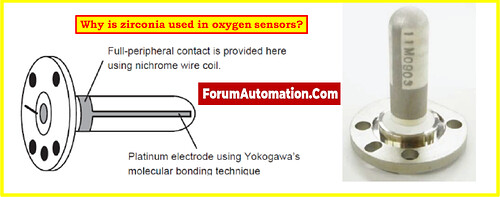- Zirconia is employed in oxygen sensors, specifically in a type of sensor called a “zirconia oxygen sensor” or “zirconia-based oxygen sensor,” due to its distinct electrical and oxygen-ion conducting capabilities.
- To detect the amount of oxygen in gases, these sensors are frequently used in a variety of applications, including automotive exhaust systems, industrial operations, and medical devices.
Why zirconia is prefered for this use is as follows:
Oxygen-Ion Conductivity:
- Zirconia is an electrolyte that is solid and has a strong oxygen-ion conductivity at high temperatures.
- Zirconia is frequently heated to a high temperature (generally between 700 and 900°C or 1292 and 1652°F) for use in oxygen sensors.
- Zirconia becomes an excellent conductor of oxygen ions (O2) at high temperatures.
Electrochemical Principle:
- Zirconia oxygen sensors work on the basis of an electrochemical reaction. The zirconia electrolyte experiences a voltage across it when exposed to an oxygen-containing atmosphere.
- From the high-oxygen (reference) side to the low-oxygen (measurement) side, oxygen ions move through the zirconia electrolyte.
- In direct proportion to the oxygen concentration in the gas being measured, this oxygen transport produces a voltage.
High Sensitivity and Accuracy:
- Zirconia sensors are capable of measuring oxygen concentrations with high precision and accuracy across a wide range. They are suitable for applications where precise control of oxygen content is essential since they are extremely sensitive to fluctuations in oxygen levels.
Durability:
- Zirconia sensors are strong and can survive challenging operating circumstances, including high temperatures and corrosive environments. For automotive applications where the sensor is exposed to exhaust fumes, its adaptability is crucial.
Fast Response Time:
- Zirconia oxygen sensors have a short response time to changes in oxygen levels, which is essential for applications that need to make immediate modifications to maintain ideal combustion conditions, like in car engines.
Low Maintenance:
- These sensors have a long operational lifespan and require very little maintenance; as a result, they are very cost-effective.
- Zirconia-based oxygen sensors have become the standard in many different industries due to their great performance features, dependability, and ability to reliably monitor oxygen concentrations in a variety of gases.

